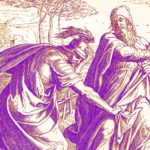Perhaps no rock band has sung a simple question as memorably—and as fittingly—as The Who: “Who are you? Who, who, who, who? Who are you?” And perhaps no question gets to the mysteries of Christology more quickly. Who was born of the virgin Mary? Who preached on the mount? Who prayed in the garden? Who died on the cross?
Answering each of these questions takes us into profound territory regarding the person and natures of Jesus Christ. But there is another question that has generated much confusion: Who did the miracles we see Jesus performing in the Gospels?
There’s been confusion around this question because it’s often been asked not with who but with how (i.e., how did Jesus work miracles?). And the way a question is asked shapes the kind of answer received.
Modern Misstep: Moving from Who to How
Many theologians of the modern era, emphasizing Christ’s humanity, have puzzled over the two natures of Christ, assuming they’re in a kind of competition. Because two natures can’t occupy the same “space” within one person, Christ’s identification with our humanity required him to always or mostly forsake the right to his divine attributes. How, then, does he perform miracles?
Scripture portrays a variety of people performing miracles. And all of these men save one are just that—mere men. When, say, Elijah or Paul performs miracles, it doesn’t point to their person. After all, when those at Lystra were tempted to worship Barnabas and Paul after Paul’s miracle, the apostle implored the crowd to remember that they were men (Acts 14:15). The Holy Spirit enabled these miracles; they were testaments to his power, not Paul’s or anyone else’s.
The miracle of the incarnation is that this one person became everything we are without ceasing to be everything he is.
To many modern theologians, Jesus’s miracles are really no different. He too did his miracles by the power of the Holy Spirit. As a result, they don’t point to his person—except insofar as Jesus relies on the Spirit—but to the human nature he shares with us. Like us, he must rely on divine resources outside himself. Thus the question of how humans perform miracles gets transposed to Christ’s miracles, all the while avoiding who he is as God’s Son.
But by giving so much room for the Spirit and the humanity of Christ, a vital Christological category is squeezed out: persons, not natures, do things. Yes, Jesus Christ has two complete natures, one divine and one human. Yes, he always acts according to both of these natures. Still, it’s the person of Jesus who confronts us in the Gospels, and Christology since Chalcedon (AD 451) has stressed that he is one united person—the second person of the Trinity. The miracle of the incarnation is that this one person became everything we are without ceasing to be everything he is. So when we see Jesus perform a miracle in the Gospels, our first question should be who is this?
Test Case: Walking on Water
On the surface, Jesus walking on water in Matthew 14 seems to affirm that he worked miracles as a man empowered by the Spirit. In Matthew’s narrative, Jesus has just finished feeding the 5,000. His disciples get into a boat on the Sea of Galilee. Rather than get in with them, however, Jesus withdraws to a mountain to pray. By the time it was between 3 and 6 a.m., the disciples’ boat is far offshore and being tossed by waves. Their fear is intensified when they see what they take for a ghost approaching them on the sea.
It’s no ghost, of course; it’s Jesus Christ. The disciples’ cry of fear is met with Jesus words: “Take heart; it is I. Do not be afraid” (Matt. 14:27). Peter then asks Jesus to prove himself by commanding him to walk on the water, too. The ensuing episode initially seems to set up a parallel between Peter and Jesus: when Peter walks by faith, he walks supernaturally on the water; when he walks by fear, he starts to sink. Jesus apparently confirms this when he reaches out his hand to Peter: “O you of little faith, why did you doubt?” (Matt.14:31).
The disciples didn’t marvel at Jesus’s complete dependence on another, nor did they ascribe praise to the Spirit’s power. Rather, their eyes are drawn to the incarnate Son of God as the one worthy of praise.
One might presume that here we have a mere man, Peter, able to do what Jesus can do so long as he walks by faith. Thus, the operating difference between Jesus and Peter isn’t that Jesus is the fully divine Son, but that in his humanity he fully relied on the Spirit. This episode, therefore, doesn’t reveal the lordship of Jesus Christ; rather, it points to the inbreaking of the kingdom and the model Jesus provides for relying on divine resources other than his own. With this reading, the who of Jesus is lost in the drive to compare and contrast the how of Peter and Jesus.
But Who Really Walked on Water?
Three clues in this passage, however, point to a different understanding of this miracle.
First, when Jesus reveals to his fearful disciples that “it is I” (Matt. 14:27; Greek ego eimi), this isn’t a call to recognize his human features that mark him out as “Jesus from Nazareth.” Rather, he’s appropriating Yahweh’s name revealed in Exodus 3:14 (I AM: ego eimi). He’s commanding his disciples to take heart and not be afraid because he, the one walking on the water, is Yahweh.
The second clue flows from the first: Jesus is taking over an Old Testament theophany motif. Who tramples the waves of the sea but Yahweh alone (Job 9:8)? Through this and his personal identification with the divine name, Jesus is making clear the who of this miracle: the incarnate second person of the Trinity who, though veiling his heavenly glory in human flesh, didn’t abandon or mute the attributes of his divine nature (as if he ever could!). No, the Creator who first fashioned the sea now masters it through his own power.
The third clue is found in the disciples’ response to this revelation. Initially we see Peter addressing this Yahweh-incarnate-who-walks-on-water as “Lord.” But then, after Jesus gets into the boat and the wind ceases, they worship him: “Truly you are the Son of God” (Matt. 14:33). It’s clear that for the disciples this miracle bears the unmistakable marks of a divine person (cf. Ps. 107:23–32). The disciples didn’t marvel at Jesus’s complete dependence on another, nor did they ascribe praise to the Spirit’s power. Rather, their eyes are drawn to the incarnate Son of God as worthy of praise. For them, the who explained the how and ushered them into worship.
Unity of the Son of God
Because the incarnate Son of God is one person with two natures, we should expect to see Gospel episodes reflective of each nature. Even in this profound revelation of Jesus’s divine power on the sea, he uses human feet to walk on water, a human arm to save Peter from sinking, and a human voice to reassure his disciples of his divine identity. Jesus is always one person acting according to both of his natures.
Many modern theologians seek to understand the mystery of the incarnation by dividing Christ, by isolating one of his natures and asking how a particular action is possible. Not only do Christological problems result; it leads to grave Trinitarian ones as well. For to suggest Jesus’s miracles aren’t touched by his divine nature is to divide the works of the Trinity, to parcel out discrete acts among the Father, Son, and Spirit. Classical Trinitarian theology, however, joins God’s essential unity (Deut. 6:4) with the co-inherence of the persons (John 14:11) and holds that every work of the Trinity is undivided. When God acts, each person acts. It’s not wrong to say that the Spirit is acting in Jesus’s miracles; he is. It is wrong to say that the second person of the Trinity isn’t.
It’s not wrong to say that the Spirit is acting in Jesus’s miracles; he is. It is wrong to say that the second person of the Trinity isn’t.
Ancient creeds like Chalcedon have taught us “to confess one and the same Son, our Lord Jesus Christ, the same perfect in Godhead and also perfect in manhood.” Many of our Christological dilemmas would be cleared up by, with Chalcedon, first answering who is Jesus. He’s the “one and the same Son,” whose miraculous deeds cause us, like those first disciples, to adore the mystery of God incarnate.
“The Most Practical and Engaging Book on Christian Living Apart from the Bible”
 “If you’re going to read just one book on Christian living and how the gospel can be applied in your life, let this be your book.”—Elisa dos Santos, Amazon reviewer.
“If you’re going to read just one book on Christian living and how the gospel can be applied in your life, let this be your book.”—Elisa dos Santos, Amazon reviewer.
In this book, seasoned church planter Jeff Vanderstelt argues that you need to become “gospel fluent”—to think about your life through the truth of the gospel and rehearse it to yourself and others.
We’re delighted to offer the Gospel Fluency: Speaking the Truths of Jesus into the Everyday Stuff of Life ebook (Crossway) to you for FREE today. Click this link to get instant access to a resource that will help you apply the gospel more confidently to every area of your life.
































